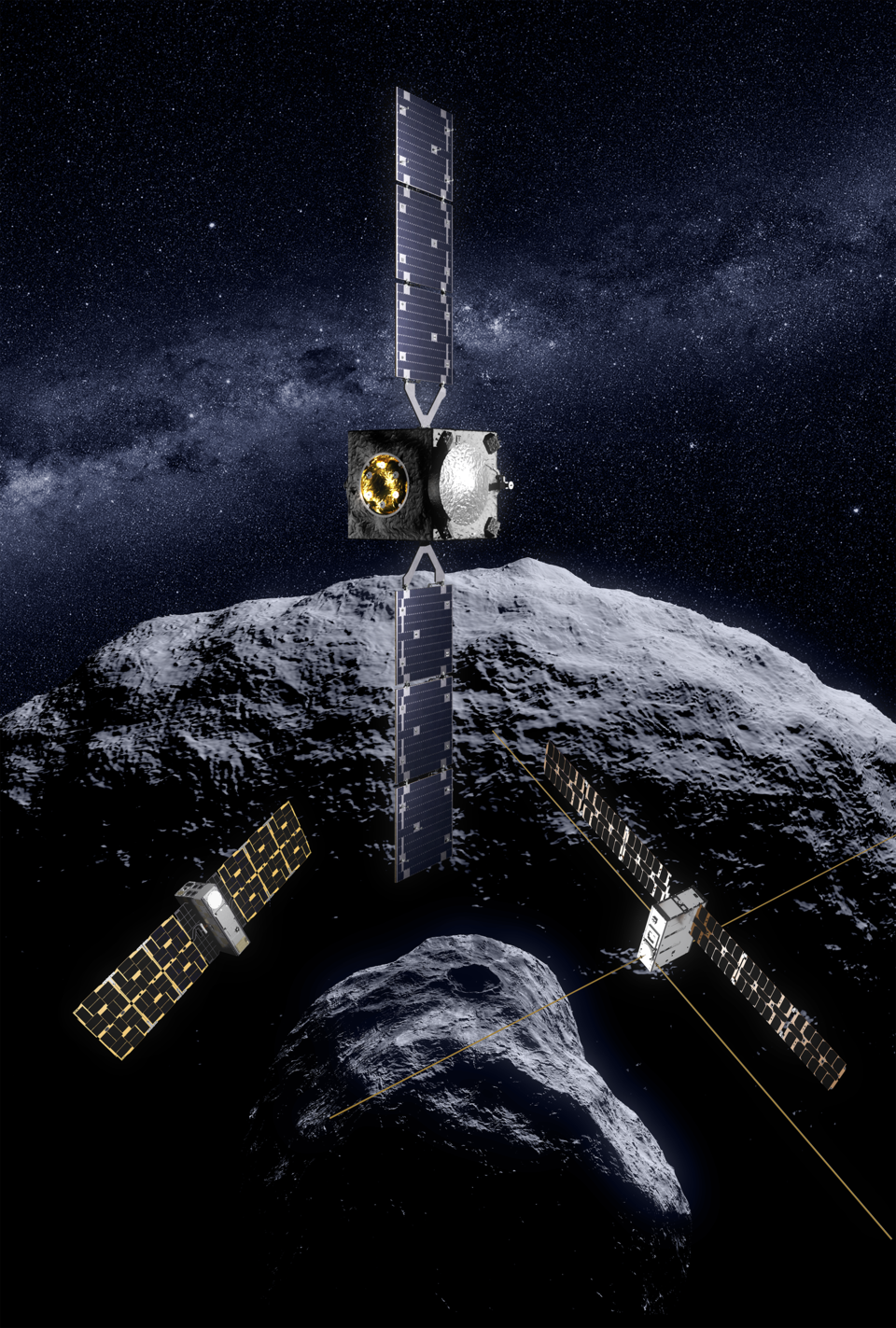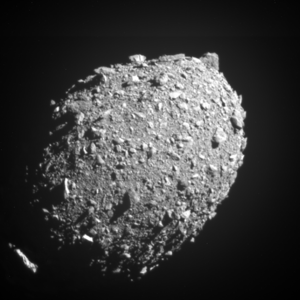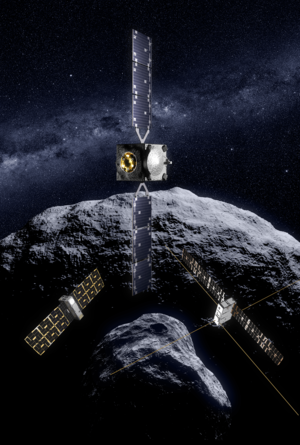Hera asteroid spacecraft assembled
Hera is complete. ESA’s asteroid mission for planetary defence was built and prepared in two halves, but now, through a painstaking operation, they have been mated together to make a single spacecraft, ready for full-scale testing of its readiness for space.

The mating took place at OHB Bremen in Germany, with Hera’s Core Module raised more than 3 m above its Propulsion Module then gradually and carefully slotted into place, over a three-hour period. The modules had been placed in cages to ensure their correct alignment relative to each other down to a few tenths of a millimetre.
“The mission keeps on hitting milestones right now, but this is a big one, and a very emotional moment for the team,” explains Paolo Martino, Hera system engineer. “Previously we had these two modules, now you can say the spacecraft has been born.”

Hera is Europe’s contribution to an international planetary defence experiment. Following the DART mission’s impact with the Dimorphos asteroid last year – modifying its orbit and sending a plume of debris thousands of kilometres out into space – Hera will return to Dimorphos to perform a close-up survey of the crater left by DART. The mission will also measure Dimorphos’ mass and make-up, along with that of the larger Didymos asteroid that Dimorphos orbits around.
To make its rendezvous with Dimorphos Hera has to lift off in October 2024. So to maximise working time the mission was constructed by prime contractor OHB as two separate modules, which could be worked on in parallel.


Access the video
Hera’s Propulsion Module incorporates its propellant tanks – housed within a central carbon fibre reinforced polymer cylinder, the ‘backbone’ of the spacecraft – along with piping and thrusters, which will have the job of hauling the mission across deep space for more than two years, then to manoeuvre around Dimorphos and Didymos.
Meanwhile Hera’s Core Module can be thought of as the brains of the mission, hosting its onboard computer, mission systems and instruments.

Manufactured together, the Core Module remained at OHB while the Propulsion Module travelled to Avio near Rome in Italy for the addition of its propulsion system. The pair were then reunited in Bremen to prepare for the mating operation.
“A similar double-module process is often used for telecom missions, but those are usually standardised designs,” adds Paolo. “This is the first time it has been applied to a deep space mission, on a much more ad hoc basis.”

The mating had been exhaustively simulated in advance using CAD software, but OHB’s assembly, integration and testing team were still checking alignment as the crane lowered the Core Module every step of the way. The cleanroom door was kept sealed during the mating to prevent any distraction.
“We studied a lot together with our designers on which were the most critical parts of the process, so most of them were already taken into account,” explains Matteo Grimaldi, Senior Assembly, Integration and Testing technician at OHB.

Once the tip of the Propulsion Module cylinder met the top deck of the Core Module the mating was complete. Then an initial test bolt was inserted to check the alignment was entirely correct in advance of the two modules being fully bolted together.
“The two modules are now together forever, as they will be in space, barring any major unexpected problem,” explains Paolo.

“If we need to, we can still access internal units through side panels. Next we will be adding some payload units to the spacecraft's top deck which we are receiving directly from the manufacturers once Hera moves to its next stop.
“That is at the end of this month, when Hera is being transported to the ESTEC Test Centre in the Netherlands, where it will go through a full-scale environmental test campaign to check its flight-readiness.”


Access the video














 Germany
Germany
 Austria
Austria
 Belgium
Belgium
 Denmark
Denmark
 Spain
Spain
 Estonia
Estonia
 Finland
Finland
 France
France
 Greece
Greece
 Hungary
Hungary
 Ireland
Ireland
 Italy
Italy
 Luxembourg
Luxembourg
 Norway
Norway
 The Netherlands
The Netherlands
 Poland
Poland
 Portugal
Portugal
 Czechia
Czechia
 Romania
Romania
 United Kingdom
United Kingdom
 Slovenia
Slovenia
 Sweden
Sweden
 Switzerland
Switzerland































